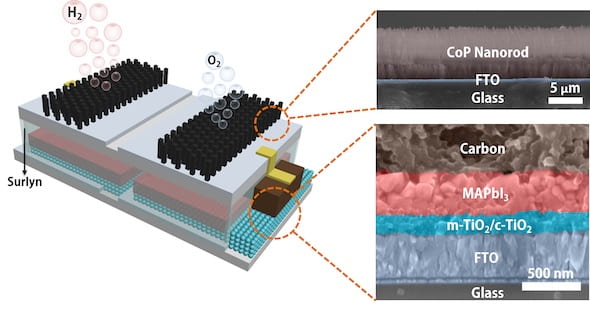From Rice University: ‘Artificial leaf’ concept inspires Rice University research into solar-powered fuel production
by Mike Williams/May 4, 2020
 A schematic and electron microscope cross-section show the structure of an integrated, solar-powered catalyst to split water into hydrogen fuel and oxygen. The module developed at Rice University can be immersed into water directly to produce fuel when exposed to sunlight. Illustration by Jia Liang
A schematic and electron microscope cross-section show the structure of an integrated, solar-powered catalyst to split water into hydrogen fuel and oxygen. The module developed at Rice University can be immersed into water directly to produce fuel when exposed to sunlight. Illustration by Jia Liang
Rice University researchers have created an efficient, low-cost device that splits water to produce hydrogen fuel. The platform developed by the Brown School of Engineering lab of Rice
materials scientist Jun Lou integrates catalytic electrodes and
perovskite solar cells that, when triggered by sunlight, produce
electricity.
The current flows to the catalysts that turn water into
hydrogen and oxygen, with a sunlight-to-hydrogen efficiency as high as
6.7%.
This sort of catalysis isn’t new, but the lab packaged a perovskite
layer and the electrodes into a single module that, when dropped into
water and placed in sunlight, produces hydrogen with no further input.
The platform introduced by Lou, lead author and Rice postdoctoral fellow Jia Liang and their colleagues in the American Chemical Society journal ACS Nano is a self-sustaining producer of fuel that, they say, should be simple to produce in bulk...
...“With a clever system design, you can potentially make a self-sustaining loop,” Lou said. “Even when there’s no sunlight, you can use stored energy in the form of chemical fuel. You can put the hydrogen and oxygen products in separate tanks and incorporate another module like a fuel cell to turn those fuels back into electricity.”...